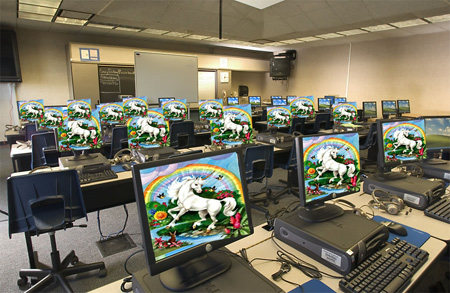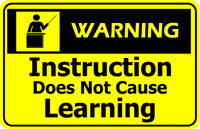I spend lots of time developing learning that lives online. e-learning, web content, videos, podcasts, support information, application forms for tractor assembly jobs — so I fancy myself as a bit of an expert in how this type of content is consumed.
(Many other people in my discipline would use less flattering terms to describe me — including references to rodents, orifices and familial relationships. But even if true — I design a bunch of online learning.)
As part of that, I joust regularly with people who teach and train in something called “The Real World”. I have a hazy memory of this place — it involves chalk boards, rows of desks, and children in freshly-pressed jumpers smiling up at me as I whack their knuckles with a wooden ruler. I rarely teach there anymore — nobody wants to pay my embarrassingly high prices, and I keep trying to click on individual students and block them.
 As they move into the world of online teaching, most “real world” practitioners attempt to bring all their baggage with them. And as the airlines have found, the more baggage you allow the more difficult it is to get the damn thing off the ground. So I’m here today to show you a few of the cherished icons of classroom instruction you’re going to have to leave at the gate if you want to succeed in the online world.
As they move into the world of online teaching, most “real world” practitioners attempt to bring all their baggage with them. And as the airlines have found, the more baggage you allow the more difficult it is to get the damn thing off the ground. So I’m here today to show you a few of the cherished icons of classroom instruction you’re going to have to leave at the gate if you want to succeed in the online world.
Everyone Does Not Stay Together
In your classroom, you can exert a good deal of control that all students advance at a controlled pace — by assigning readings, presentations, and in-class activities. You’ll find that online students will lag behind and race ahead. Some will have questions about section 14 on the third day of class. Oopsie.
So you’d best be prepared on Day 1 to teach the whole thing, or you’ll take the wind out of the sails of the students who are really engaged. And you’ll have to be willing to support someone who’s going back to the beginning for a refresher during the last week.
Everyone Expects Personalized Support
Blame it on Tony Hsieh of Zappos — a large number of your students will now expect to interact with you via email, chat, FaceBook, Twitter, LinkedIn, Google+, Snoozle, Schmaltz, Fizzle, Abdalo, Whackadoodle — ok, I was just making up those last few. But you get the picture. If you’re not careful about designing how you set up your assignments, your workload will go up exponentially.
Be sure that you set your assignments up so that students interact with each other, rather than always depending on you. Be sure that you become an Online Facilitator, and let go of the idea that all learning comes from you. Be sure that you spend some time learning new skills for this new role that you’ve taken on.
Everyone Will Not View Every Screen
Do you have a DVR? If so, I bet you don’t watch commercials. Or the boring parts. And your e-learning students are going to do that, as well. In your classroom, they sat their in their seats and pretended to listen during the boring parts. Online, they’re just going to skip past the things they don’t want to pay attention to. (I always find it amusing when teachers complain about learners ignoring boring online content. I ask them what they, personally, do during the sermon in church.)
So you’d better make sure the e-learning you’re using is interesting, engaging, and makes your learners want to pay attention. Or find a way to introduce it so they will.
Quit Measuring Stuff You Don’t Track
There’s no reason to add in all those little “Check Your Understanding” and “Quick Quiz” screens throughout the e-learning, unless you’re going to collect the data and use if for something. Only three possible outcomes:
- Student actually knows the answer. Wow.
- Student doesn’t know the answer. Unless you force them back through the content, you just make them feel dumb. Wow.
- Student skips past the test — which the majority will do. Wow.
If you feel you must do this, just have a question and the correct answer on the next screen, like a flashcard. That way you’re reinforcing a positive. There’s good data to support that. And you can re-use that content for test prep at the end of the course.
Let The Inmates Build The Prison
As I’ve mentioned above, you need to start thinking more like a “facilitator” than a “teacher”. You’re guiding this group of learners through the curriculum, and no longer the main source of knowledge. Let them learn from each other, from resources you provide (and that they find and vet through you), bring in live humans via Skype or Webcasts, have them do original research and share — be creative in how each new class discovers information.
Each course will look different, and that’s ok. Each group of learners will approach the problems in a different manner, and the shared knowledge that they create will be unique. That’s one of the amazing parts of online learning — those “Poindexters” that sit in the front row will fade into the background, and you’ll meet a whole new group of people you never heard from before.
 I read this research on the Internet, so it has to be true. Learning hurts your brain. I first began to suspect this was true in 4th Grade Spanish class with Mrs. Gonzalez, where I was called “Ricardo” for reasons that remained a mystery to me all year long. (Hey — I’m just visiting your country for an hour a day. I’m not planning on renouncing my citizenship and living here as an ex-pat like Hemingway, lady.) But I digress.
I read this research on the Internet, so it has to be true. Learning hurts your brain. I first began to suspect this was true in 4th Grade Spanish class with Mrs. Gonzalez, where I was called “Ricardo” for reasons that remained a mystery to me all year long. (Hey — I’m just visiting your country for an hour a day. I’m not planning on renouncing my citizenship and living here as an ex-pat like Hemingway, lady.) But I digress.

 Last week I was having a nice conversation with a new online friend about helping her move her “in-person” teaching into the land of the Interwebs. (This is a conversation that I’ve now had 21,586 times — since I do this sort of thing for a living — so I’m getting better and better at it.) As usual, she was bemoaning the fact that there were parts of the in-person teaching experience that you “just couldn’t translate” into the online world.
Last week I was having a nice conversation with a new online friend about helping her move her “in-person” teaching into the land of the Interwebs. (This is a conversation that I’ve now had 21,586 times — since I do this sort of thing for a living — so I’m getting better and better at it.) As usual, she was bemoaning the fact that there were parts of the in-person teaching experience that you “just couldn’t translate” into the online world.


